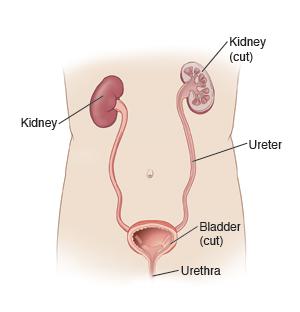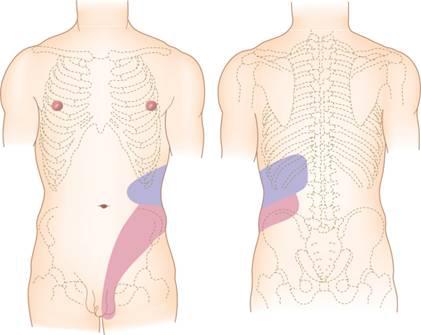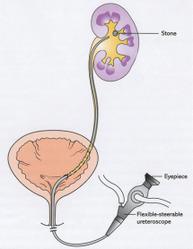Urinary Stone Disease
- Home
- Treatments
- Urinary Stone Disease
Understanding Urinary Stone Disease
 ajan, a 60-year-old banker has seen it all. He has lived with and suffered due to urinary stones from his college days for over 35 years.
ajan, a 60-year-old banker has seen it all. He has lived with and suffered due to urinary stones from his college days for over 35 years. At the age of about 20 years he was found to have a large stone in his left kidney. The only facility he had that time was to get it removed surgically. A large cut was made in his flank to remove the 3 cm stone. He spent over 10 days in hospital and was out of college for nearly six weeks. Sadly, one small stone fragment was left behind during the open surgery. Open surgeries carry this risk as they are not done under X-ray control.
What are Kidney Stones?

How do the Kidneys and Urinary System Work?
-
- A sharp, cramping pain in the back,flank and side.The pain often moves to the lower abdomen or groin.Some women say the pain is worse than childbirth labor pains (so this is the most severe pain a man will go through!!).The pain can start quickly and come in episodes.It can come and go as the body tries to get rid of the stone. Pain may be associated with nausea vomiting or fever.
-
- A feeling of intense need to urinate.
-
- Going to the bathroom more often or having a burning feeling when you go.
-
- Urine that is dark or red due to blood.Or sometimes urine has red blood cells that can’t be seen with the naked eye.
-
- Nausea and vomiting.
- Men may feel pain at the tip of their penis

What are Kidney Stones Made of?
Uric acid is a waste product that comes from chemical changes in the body. Uric acid crystals do not dissolve well in acidic urine. Instead it will form a uric acid stone.
Having acidic urine may come from:
- Being overweight
- Chronic diarrhea
- Type 2 diabetes (high blood sugar)
- Gout
- A diet that is high in animal protein and low in fruits and vegetables
Struvite stones are common type of stone in Indian population. These stones are related to chronic urinary tract infections (UTIs). Some bacteria make the urine less acidic and more basic or alkaline. Magnesium ammonium phosphate (struvite) stones form in alkaline urine. These stones are often large, with branches, and they often grow very fast.
People who get chronic UTIs, such as those with long-term tubes in their kidneys or bladders, or people with poor bladder emptying due to neurologic disorders (paralysis, multiple sclerosis, and spina bifida) are at the highest risk for developing these stones. These can also happen in persons with uncontrolled diabetes.
What Causes Kidney Stones?
Concentrated urine means there is less fluid to keep salts dissolved. Drinking more will lower the salts in your urine. By doing this, you may lower your risk of stones forming.
If you’ve had stones, you should drink enough fluid to make at least 2.5 liters of urine every day. On average, this will take about 3-4 liters of fluid intake per day. This will depend on your work environment. While water is the best thing to drink, what matters most is getting enough fluid. The water intake should be in form of small amount of liquids at regular interval.
To know adequacy of the urine production, you should need to go to the bathroom 7-8 times per day and the urine color should be like water every time.
Avoiding foods rich in oxalate is a good idea.
One of the more common causes of calcium kidney stones is high levels of calcium in urine. High urine levels may be from the way your body handles calcium. It is not always due to how much calcium you eat. Studies show that lowering calcium in your diet can be bad for bone health and may increase kidney stone risk. People are not often asked to limit dietary calcium, but they also shouldn’t eat too much. Instead of eating less calcium, your doctor may try to reduce your urine calcium level by asking you to eat less sodium. Too much salt in the diet is a risk factor for calcium stones. This is because too much salt keeps calcium from being reabsorbed from the urine into the blood. Reducing salt in the diet makes it less likely for calcium stones to form.
Certain bowel conditions can raise the risk of forming calcium oxalate kidney stones. For example, conditions that cause diarrhea (such as Crohn’s Disease or ulcerative colitis) or surgeries (such as gastric bypass surgery done for weight loss) can cause stones. Diarrhea may result in the loss of large amounts of fluid from the body, lowering urine volume. Your body may also absorb too much oxalate from the intestine. This causes more oxalate in your urine. Both low urine volume and high levels of urine oxalate can form calcium oxalate kidney stones.
How are Kidney Stones Diagnosed?
Get Treated
- The type of stone
- Location of the stone
- How bad it is
- Length of time you have had symptoms.
Waiting 3 to 4 weeks for the stone to pass is safe as long as the pain is bearable, there is no infection, the kidney is not blocked and the stone is small enough to pass.While waiting for the stone to pass, you should drink adequate amounts of water.You may need pain medication.
Adequate physical activity also helps the stone to move. Smaller stones and stones closer to the bladder will likely pass on their own. Spontaneous stone passage is more common in young non-diabetic physically active individuals.
Certain medications have been shown to help stones pass.The most common medicine prescribed is Tamsulosin.Tamsulosin relaxes the ureter, making it easier for the stone to pass.You may also need pain and anti-nausea medicine as you wait.
- The stone fails to pass or too large to pass.
- The pain is too great to wait for the stone to pass.
- The stone is affecting kidney function.
Surgeries to remove stones in the kidneys or ureters are:
SHOCK WAVE LITHOTRIPSY (SWL)
With SWL, you may go home the same day as the procedure.You may be able to resume normal activities in 2 to 3 days.You can use a strainer to collect the stone pieces as they pass.These pieces will be sent to a lab to be tested.
Although SWL is widely used and considered very safe, it can still cause side effects.You may have blood in your urine for a few days after treatment.Most stone pieces pass painlessly.Larger pieces may get stuck in the ureter, causing pain and the need for other removal procedures.


URETEROSCOPY (URS)
The ureteroscope lets the urologist see the stone without making an incision (cut).General anesthesia keeps you comfortable during the URS procedure.Once the urologist sees the stone with the ureteroscope, a small, basket-like device grabs smaller stones and removes them.If a stone is too large to remove in one piece, it can be broken into smaller pieces with a laser or other stone-breaking tools.
Once the stone has been removed in whole or in pieces, your doctor may place a temporary stentin the ureter.A stent is a tiny, rigid plastic tube that helps hold the ureter open so that urine can drain from the kidney into the bladder.Unlike a catheter, this tube is completely within the body.It does not require an external bag to collect urine.
You may go home the next day after the URS and can begin normal activities in 2 to 3 days.If your urologist places a stent, he or she will remove it 14 to 21 days later.It is very important to remember to remove the stent when your urologist tells you.Leaving the stent in for long periods can cause an infection and loss of kidney function.
PERCUTANEOUS NEPHROLITHOTOMY (PCNL)
After the PCNL, a tube may be left in the kidney to drain urine into a bag outside the body (nephrostomy bag).The tube is usually left in overnight or for a few days.You may have to stay in the hospital for 36-48 hours after this operation.
Your urologist may choose to do X-rays while you are still in the hospital to confirm stone clearance. You can begin normal activities after about 1 to 2 weeks.

Other Surgery
Prevention
- Have you had more than one kidney stone before?
- Has anyone in your family had stones?
- Do you have a medical condition that may increase your chance of having stones, like frequent diarrhea, gout or diabetes?
Diet Tips To Prevent Stone
Knowing how much you drink during the day can help you understand how much you need to drink to produce 2.5 liters of urine.Use a household measuring cup to measure how much liquid you drink for a day or two.Drink from bottles or cans with the fluid volume on the label.Keep a log, and add up at the end of the day or 24-hour period.Use this total to be sure you are reaching your daily target urine amount of at least 2.5 liters of urine daily.
One simple way is to assure that you need to go to the loo minimum 7-8 times in 24 hours. Observe the color of the urine, it should be water colored always. Having a dilute urine is the most important precaution in reducing the risk of recurrence.
- Papads, Aachars and chutneys
- Extra table salt
- Cheese (all types)
- Most frozen foods and meats.
- Canned soups and vegetables
- Breads, rolls and baked goods
- Salty snacks, like chips and pretzels
- Bottled salad dressings and certain breakfast cereals
- Pizza and lasagna
- Canned and bottled sauces
- Certain condiments, table salt and some spice blends
A serving means one piece of fruit or one potato or one cup of raw vegetables. For cooked vegetables, a serving is ½ cup. If you are worried you may not be eating the right amount of fruits and vegetables, talk to your doctor about what will be best for you.
Remember: foods with seeds in them DO NOT cause stones!!
If your doctor thinks your diet is increasing your risk for stones, he or she will tell you to eat less meat, fish, seafood, poultry, pork, lamb, mutton and game meat than you eat now. This might mean eating fewer times during the week, or eating smaller portions when you do eat them. Having one vegetarian dish with animal protein is a good idea. The amount to limit depends on how much you eat now and how much your diet is affecting your uric acid levels.
Frequently asked questions
If you form stones often, you will need monitoring with X-rays and urine studies to be sure no new stones are forming. Your doctor will monitor you to make sure your medications and diet changes are working.
Stones smaller than 6 mm would pass out on their own, but they need a medical supervision to document their movement down the ureter and to confirm complete clearance.
Yes, I have met a lot of patients who have gone to such places for removal of their stones. In fact, one of our patients was so convinced that his stone has been removed by magic that he refused to get himself investigated. There is no truth in this as far as we know and have seen. The proof is that these patients had to come to us for definitive treatment. What these people do is perform some sort of puja and give the patient a stone that has probably been picked up from the road. Because of the faith and some amount of coincidence, the patient does not get pain after that for some time (stone pain usually comes in episodes that may be spread over months or years). The patient realizes much later when he gets the next episode of pain that the stone is still there. Again, I would like to stress here that please get whatever form of treatment you have faith in but you must confirm complete stone removal by X-rays and sonography. Accept only those treatment options that can give an assured clearance in less than three months.
Friends, please do not have beer for stone clearance. Enjoy it if you please, but please do not use stone as an excuse.
- Papads, Aachars and chutneys
- Extra table salt
- Cheese (all types)
- Most frozen foods and meats.
- Canned soups and vegetables
- Breads, rolls and baked goods
- Salty snacks, like chips and pretzels
- Bottled salad dressings and certain breakfast cereals
- Pizza and lasagna
- Canned and bottled sauces
- Certain condiments, table salt and some spice blends
Yes. Urinary stone is an un-welcome friend for life! Once it forms it is likely to form again. The risk of recurrence of stone disease is there all through out your life hence your diet and fluid care is a permanent feature.
- A basic metabolic evaluation is necessary for every patient. This is a screening test for any etiology for stone disease.
- The person who is more likely to have recurrent stones may have one of these attributes. Has formed stones previously.
- Have multiple stones.
- Has stone in both his kidneys.
- Family history of stone disease is positive.
- Has formed stone at a young age.
This class of patients needs extra care. They need specialized investigations (Complete Metabolic evaluation) to rule out any predisposing cause. The investigations are in the form of few blood and urine tests. The urine is tested over 24 hours on more that two occasions.
Myth : Kidney stones are rare.
Fact : Kidney stones are one of the most common disorders of the urinary tract.
Myth : Only men get kidney stones.
Fact : Women get kidney stones too. Even children can get them.
Myth : Eating certain foods will cause kidney stones to develop.
Fact : Not usually.
Myth : Most kidney stones are formed from calcium, so calcium in the diet should be reduced.
Fact : That used to be what doctors thought, but no longer.
Myth : Most people with kidney stones have to undergo surgery.
Fact : Thankfully, this isn’t true any longer.
Myth : Once as person has kidney stones, there’s nothing that can be done to prevent future stones.
Fact : Most people can take action to reduce their risk of getting more stones.
Myth : If a person has kidney stones, he or she is more likely to have gallstones.
Fact : Not even close.
- Have adequate oral fluid intake. Aim to produce about 2500 ml urine in a day. You should drink small amount of fluids at frequent intervals. Any type of liquid is OK; water, sherbet, juice, coconut water.
- Avoid drinks like excessive tea & coffee, beer (Beer has a lot of oxalate and uric acid, it increases stone formation) & aerated drinks.
- It is not necessary to stop milk totally. A global restriction of diary products may increase risk of phosphatic stone formation in some patients. Also calcium is very vital for our bones & muscles. Patients can safely have milk & milk products equivalent to half a liter of milk every day (1000mg per day)
- It is NOT necessary to stop tomatoes, palak, brinjal, & all stuff having seeds. Seeds do not cause stones.
- Restrict mutton and red meat.
- Restrict table salt and foods containing excessive salt: papad, aachar, chutneys etc.
- Restrict the use of Pan & Gutka. This has an excess dose of lime in it. This high dose of calcium may lead to stone growth.
- Regular exercise is very important. Fast walking, jogging or skipping would be very good.
- Avoid constipation.
- Increase fiber in your diet; fresh fruits, green leafy vegetables, salads.
- May take some laxatives if necessary.
- Definitive dietary restrictions are necessary only after proper metabolic evaluation.
